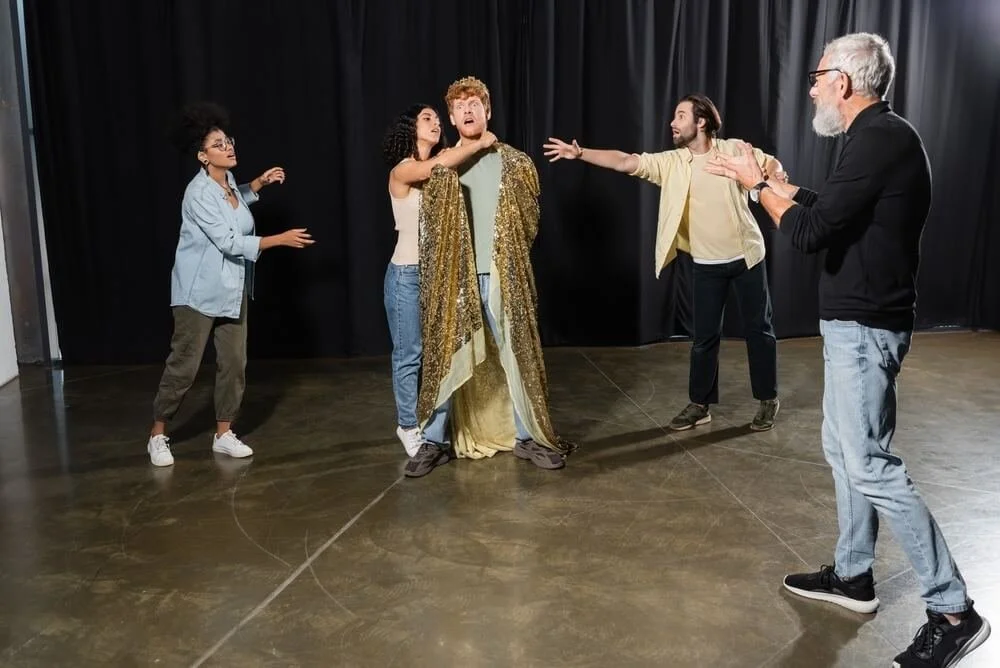“Help! My Actors Are Just Standing There!” — A Practical, Passionate Guide to Blocking
by Chris Peterson, OnStage Blog Founder
Let’s be honest: nothing makes an audience check out faster than a scene where everyone just… stands there. No movement. No purpose. No life. Blocking is not just about making sure your actors don’t bump into the furniture. It is about telling the story physically, visually, and emotionally. So if you're a director trying to figure out how to block a scene and you're staring at your script like it just personally offended you… breathe. You’ve got this. And here’s how:
Start with the story, not the stage picture
Blocking isn’t about arranging human furniture. It’s about embodying the intention of the scene. What is the moment really about? Who wants what? Who’s resisting it? Who’s changing? Who’s hiding? Until you can answer those questions, don’t even think about telling your actor to move to the left.
The emotional engine of the scene should drive the physical movement. Characters are not chess pieces; they are people reacting to circumstances, stakes, and each other. Prioritize the storytelling, and the staging will follow naturally.
Let your actors live in the scene first
Before slapping down stage directions, let the actors explore. Read the scene together, stand it on its feet, and just see what happens. A lot of great movement is born from natural instincts — a character turning away when vulnerable, leaning in when desperate, or sitting down when defeated. Blocking shouldn’t feel imposed. It should feel discovered.
Give your cast the space to play and experiment. You may be surprised what truth emerges when they are given permission to move with emotional honesty. Observe, adapt, and shape their impulses into something theatrical.
Make every movement mean something
This is the golden rule. Movement for the sake of movement is just traffic. But movement with purpose? That’s theatre. If a character crosses the stage, why? What shifted in the scene to make them move? If they sit, is it comfort? Power? Defeat? Don’t let anything be accidental.
Every shift on stage should reflect a shift in the character’s inner world. Think of blocking as physical punctuation. Are they making a point? Asking a question? Making a bold decision? Let the movement speak louder than words.
Use levels, space, and silence
Great blocking plays with the entire stage. Let people rise, fall, isolate, invade. A scene where one person is seated and another is towering over them tells a different story than two people sitting side by side. And don’t forget the power of stillness. Sometimes a character not moving is the loudest choice.
Stage dynamics are emotional dynamics. Play with distance and proximity to suggest connection or alienation. Let silence stretch or collapse depending on what is unspoken. This is where you turn subtext into visual metaphor, and the audience leans forward.
Respect sightlines and staging basics, but don’t be a slave to them
Yes, yes, we know. Don’t turn your back to the audience. Cheat out. Use triangles. All important stuff. But don’t contort your staging to follow "rules" if it crushes the moment. We’re not directing mannequins. We’re creating moments. Make bold choices and then adjust them so the audience can see the magic.
Sightlines matter, but not more than the truth of the scene. Adjust blocking when necessary, but never let a technical note dull emotional authenticity. Great staging is both visible and invisible, striking that perfect balance between clarity and conviction.\
Rehearse the emotion, not just the path
Blocking isn’t done just because you said “you cross here and you sit there.” Keep rehearsing the why behind each move. That’s how blocking sticks — not through rote memorization, but through emotional logic. When actors know why they’re moving, they won’t forget it.
They are not following stage maps. They are reacting to stakes. If someone forgets where to go, it is probably because they forgot the emotional reason. Anchor the movement to the moment. That is how you avoid robotic performances and create true connection.
And please… don’t block from your seat
Get up. Move with your actors. Feel the energy of the space. You can’t truly shape a scene from the safety of the fifth row, arms crossed, sipping a coffee. Theatre is live, kinetic, pulsing. Be part of it.
You’ll notice things standing next to your cast that you would miss from afar. Where tension lives, where timing stutters, where energy rises. Direction is a contact sport. Put your feet on the floor and be in the room where it happens.
Blocking a scene is part choreography, part psychology, and part magic trick. It’s where the invisible work of intention becomes visible. It’s how you make a play move. So trust your instincts, trust your actors, and most importantly, trust the story. The stage is waiting.
